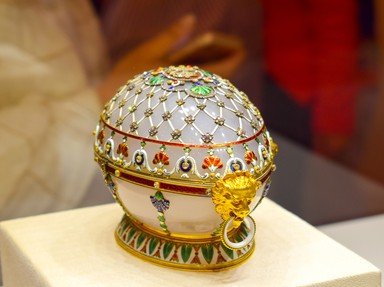Quiz Answer Key and Fun Facts
1. The Imperial Easter Eggs were created between 1885 and 1917 for which two Tsars of Russia?
2. In 1885, Peter Carl Faberge created what is appropriately known as "The First Imperial Easter Egg". On the exterior this strongly resembled a real hen's egg of white enamel. Like all the eggs, it containes a "surprise". What is in the "First Egg"?
3. The next egg is usually dated between 1885 and 1891. Traditionally it is supposed to have been a gift to the Tsarina Maria, but it is now thought more likely to be a gift to the Czarevitch, or Crown Prince. Its surprise is a blue agate rabbit with ruby eyes. What is its traditional name?
4. At Easter, 1891, the Czar presented his wife with the "Azova" Egg. It is made of a semiprecious stone known as heliotrope overlaid with gold scrolls in the rococo style. What is another more common name for the mineral heliotrope?
5. The "Azova Egg" is named for its surprise, a fantastically detailed model of a ship in gold and platinum, precise down to the tiny windows made of diamonds, sailing on a "sea" of aquamarine. All in an egg less than four inches long. What does this model commemorate?
6. Another gift from Czar Alexander to his wife is the "Imperial Spring Flowers Egg". It opens with a catch similar to an old fashoned coin purse and inside, on a pedestal, is the surprise for which the egg is named; a platinum basket set with diamond containing a bouquet of spring flowers. What sort of early blooming flowers are represented?
7. The "Imperial Caucasus Egg" is named for the royal family's mountain retreat at Abastouman in the Caucasus Mountains. Each of the four oval doors around the red enamel egg bears one diamond-studded numeral; together, they read the year "1893". Each opens on a tiny painting of a scene of the mountain retreat. The Grand Duke George Alexandrovitch spent much of his life at Abastouman, why?
8. The "Renaissance Egg' is one of the few eggs made to be displayed on its side rather than standing on one end. It is also one of the few eggs modeled closely on a known prototype. In what museum will be found the original from which the idea was taken?
9. The first egg Czar Nicholas gave his mother after his father's death is named after its surprise, a miniature screen of ten panels depicting royal residences and two royal yachts of her native country. In what country was the Dowager Empress born?
10. In 1897 the Czar gave an egg to his wife the Czarina Alexandra to commemorate their coronation in 1896. "The Coronation Egg" is of golden yellow enamel with a trelliswork of golden laurel leaves. At each intersection is an Imperial double-headed eagle in black enamel. The design is based on the mantle worn by the Czarina Alexandra when she was crowned. What is the extraordinary surprise chosen for this egg?
Source: Author
griffinj
This quiz was reviewed by FunTrivia editor
agony before going online.
Any errors found in FunTrivia content are routinely corrected through our feedback system.

